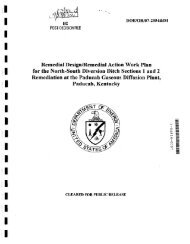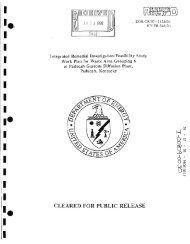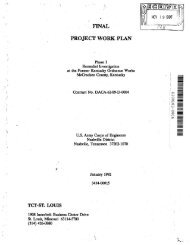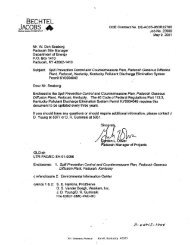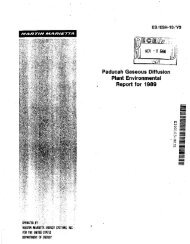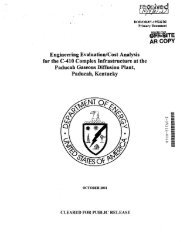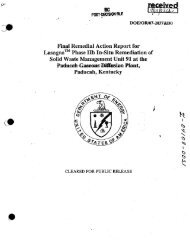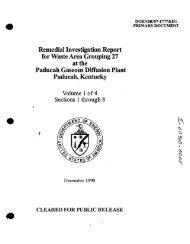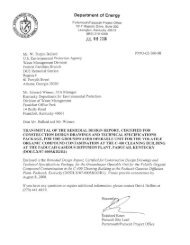1 - paducah environmental information center
1 - paducah environmental information center
1 - paducah environmental information center
Create successful ePaper yourself
Turn your PDF publications into a flip-book with our unique Google optimized e-Paper software.
Paducah Site<br />
i·<br />
I<br />
Airborne Effluents<br />
Airborne Effluent Applicable Regulations<br />
'fhe CAA at the Paducah Site is<br />
administered by KDAQ. DOE has responsibility<br />
only for air emission sources under DOE<br />
program control; therefore, this report does not<br />
address emissions from the PGDP sources leased<br />
to USEC.<br />
Airborne Effluent Monitoring Program<br />
The two point sources of air emissions for<br />
the Paducah Site in 1999 were the Northwest<br />
Plume Groundwater System and the Northeast<br />
Plume Containment System. These systems<br />
combined removed 2,676 pounds (1.3 tons) of<br />
TCE (a VOC) from the groundwater. These<br />
facilities remove TCE contamination from the<br />
groundwater by air stripping. At the Northwest<br />
Plume Groundwater System, TCE-Iaden air<br />
passes through carbon filtration which removes<br />
much of the TCE. The air stream is then released<br />
to the atmosphere where the remaining TCE<br />
naturally breaks down.<br />
The CAAdefines VOC emissions as<br />
criteria pollutants. A minor source is limited to<br />
100 tons per year of each criteria pollutant. If<br />
greater quantities of criteria pollutants are<br />
emitted, then the source is classified as a major<br />
source. A minor source has less stringent permit<br />
requirements because of the reduced potential<br />
for health effects from the smaller amount of<br />
emissions.<br />
The CAA also limits the emissions from a<br />
minor source of hazardous air pollutants (HAPs)<br />
to 10 tons/ year for each individual pollutant and<br />
25 tons/year for all HAPs combined. TCE is a<br />
HAP. The greatest amount of HAP emitted in<br />
1999 was less than the 2,676 pounds,(1.3 tons)<br />
of TCE removed from the groundwater from the<br />
combination of the Northwest Plume<br />
Groundwater System and the Northeast Plume<br />
Containment System.<br />
liquid Effluents<br />
Liquid Effluent Applicable Regulations<br />
The CW A is administered for the Paducah<br />
Site by KDOW through the KPDES Wastewater<br />
Discharge Permitting· Program. The sitewide<br />
KPDES permit (KY0004049) became effective<br />
April 1, 1998, and will expire on March 31,<br />
2003. This permit contains limits based on water<br />
quality criteria for a zero~flow receiving stream.<br />
KDWM specifies in landfill permits 073-<br />
00014, 073-00015, and 073-00045 that surface<br />
runoff be analyzed to ensure that landfill<br />
constituents are not discharging into nearby<br />
receiving streams.<br />
Liquid Effluent Monitoring Program<br />
DOE conducts nonradiological effluent<br />
monitoring for outfalls under its jurisdiction<br />
(Figure 4.1). Outfalls, 001, 015, 017, and 019<br />
were monitored for KPDES permit parameters.<br />
Title 40, Code of Federal Regulations, Part 136<br />
(40 CFR 136), lists the specific sample<br />
collection, preservation, and analytical methods<br />
acceptable for the types of pollutants analyzed.<br />
Preservation in the field is conducted per 40 CPR<br />
136, and chain-of-custody procedures are<br />
followed after collection and during transport to<br />
the analytical laboratory. The samples are then<br />
accepted by.the laboratory and analyzed per 40<br />
CPR 136 procedures for the parameters required<br />
by the KPDES permit.<br />
Surface runoff from the closed C-746-S<br />
residential landfill, the closed C-746-T inert<br />
landfill, and the operating C-7 46-U landfill was<br />
monitored quarterly. Grab samples were<br />
monitored for chloride, sulfate, pH, sodium,<br />
7-2<br />
Nonradiological Effluent Monitoring



